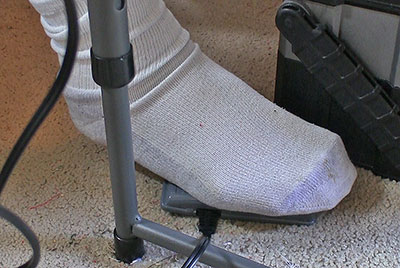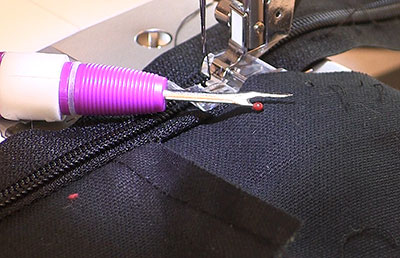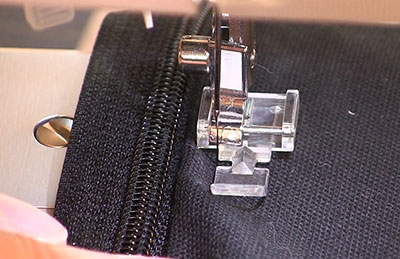 Home - How-To's - Reviews - Links - Contact - About Us
Home - How-To's - Reviews - Links - Contact - About UsOur other sites: FlyingRC.net - NewWoodworker.com - NewMetalworker.com
 Home - How-To's - Reviews - Links - Contact - About Us
Home - How-To's - Reviews - Links - Contact - About Us
Text, photos and video by Tom Hintz
Posted –5-18-2018
I know, I’ve seen the (usually women) workers in factories sewing at dizzying speeds and producing perfect-looking lines of stitches. Certainly, those persons have lots of experience that enables them to sew so fast with near perfect accuracy. While factory-based “piece work” pay concepts along with productivity targets give workers ample reason to “gas it”. Home-based sewing has no such incentives but there is a sinister side to modern sewing machine design – the “pedal”.
If history teaches us anything it is that combine a male foot with anything resembling a gas pedal and we will find out just how fast that machine will run. While some machines are meant to operate at speed, just as many are more productive at lower, more sensible speeds. I think the sewing machine is in that grouping of machines. I’d like to say that I have always run my sewing machines at job-appropriate speeds, the truth is I have gassed my way into errant lines of stitches that have provided study material on the use of seam rippers.
We must understand that a sewing machine has a relatively large reciprocating mass for its overall size and weight. Higher-priced machines are better balanced making them easier to use accurately because you can see what is going on more clearly.
I discovered that lower priced machines also work to reveal the stability of the surface on which we put it. I have a folding table that I occasionally use at the flying field but more often it becomes my sewing surface in the house. The problem is that I saved a few bucks on the table and consequently, it is more flexible than I anticipated. If I keep the speed at which I sew down to reasonable (accurate) levels the shaking is minimized. Gas it and rather than see the needle area clearly it can blur making it all but impossible to be accurate.
When I began slowing whatever sewing machine I had on this table I noticed the correlation between speed and the shaking. Moving the machine closer to a corner of the table (much better support) helped but not as much as simply slowing down a little. Then I was more accurate as well. Even I catch on eventually.
It turns out that sewing machine foot pedals are essentially variable speed controls. Being able to run the machine at a slower speeds allows the operator more time to guide the fabric as it encounters the needle. This is important when making straight stitch lines but add a curved seam and reducing speed somewhat makes it far easier to follow that path accurately and we do not have to shift gears or watch for speed traps. It just makes sense, a concept that escapes part of the human race when provided with what looks and feels like a gas pedal.

Another reality is the capability of the machine itself, particularly when it was purchased based more on price than quality. Even simple sewing machines have complex mechanisms that allow making such small stitches consistently. Factor in surprisingly large numbers of special-need and decorative stitch patterns and the cost of manufacturing the machine goes up. When the price of a sewing machine goes down the accuracy and capabilities go down with it. Run such a “bargain” machine at higher speeds and the accuracy and dependability go down. This is where the “no free lunch” adage bites us in the pin cushion. One of the things that surprised me when I began looking at modern sewing machines is that overall, they were cheaper than I expected. That’s a good thing but we cannot lose sight of the fact that a $100 machine isn’t going to embody the capabilities, accuracy or dependability of a $400 machine. Whine if you must but even in the sewing world there is no free lunch.
Another useful sewing machine control is adjustable stitch length. There are many logical uses that make variable stitch length handy. While preparing for this story I was paying attention to what I did to make the sewing machine more user-friendly, specifically “Tom friendly”. In our pursuit of accuracy stitch length can be considered a transmission with a slightly different gear for each of its settings.
Longer stitch lengths move the fabric more quickly in proportion to the foot speed control. Obviously, this makes steering the fabric to keep the stitch line where we want it more difficult, particularly with seams that are not straight or gently curved. Shorten the stitch length and the lower fabric speed lets us focus on guiding the fabric to the needle on the line wanted. Shorter stitches also make much cleaner looking curved lines.
Sewing is no different than any other learned skill. Mastering the functions and tasks that enable us to complete projects is easier when using the controls effectively. Those same controls can be used to tweak the machines performance to make us more compatible with it. This is going to be especially hard for the guys but resisting the urge to “just gas it” is important. One of the things that struck me about sewing in general is that doing good work on these machines relates to fine control.

Better sewing machines is always an advantage but how we use them is even more important. The performance of the best machines can easily be compromised by bad technique, including “gassing it”. Slowing down a little can make projects go faster simply through not having to re-do steps along the way.
I am way better with a seam ripper these days primarily because I thought I should be able to sew faster. Eventually even I saw the light and trained myself to slow down a little while paying more attention to the details. I see this slowing down as part of the process to work faster, but after I learn the basics. I have yet to find a task or skill that cannot be improved with a better understanding of the basics.
See our video on this product - Click Here
Have a comment on this story? –Email Me!
Back to the How-To list – Click Here
All yesmensew.com written, photographic and drawn materials are property of and copyright by Tom Hintz and NewWoodworker.com LLC 2013-2019. Materials cannot be used in any way without the prior written permission of the owner.